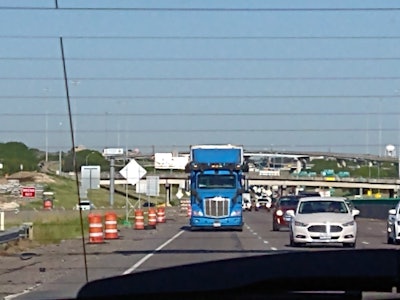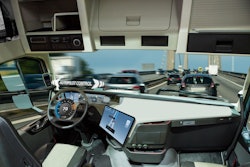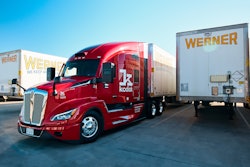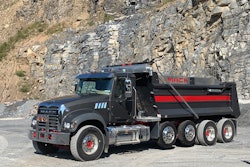
I’ve finally seen an autonomous truck in the wild.
Like hunting for the elusive bigfoot, I’ve even got the requisite grainy camera image to prove it. I’ve been reading for months about all the autonomous vehicle (AV) testing going on in Texas with the epicenter being the Dallas-Fort Worth metroplex. I can finally confirm they do exist.
The sighting occurred in rush hour traffic on Interstate 20 in DeSoto, Texas, on my drive to the MOVE America 2022 event in Austin.
I spent an afternoon at MOVE listening to speakers — from TuSimple, Locomotion, Volvo Automation, Plus AI, Torc, Solo AVT, Gatik, Kodiak Robotics, Einride and others — discussing the many benefits of autonomous trucks. The major benefits could be categorized as improving safety, reducing operating costs and increasing asset utilization. All valid claims in my estimation.
What was missing from all the positive AV energy and accolades was any significant discussion of any real-world cause-effect ramifications of AVs.
Regarding safety of autonomous trucks, computer-based automation is predictable, repeatable, consistent and, in time, should reduce accident rates. However, dealing with the unknowns, especially combinations or permutations of uncontrolled factors, still will challenge the software and sensors.
“Typical” predictable accident modes should be greatly reduced, no question there. But the real world continually demonstrates that predictions have their limitations. I expect that while accident rates will go down, the severity of any remaining AV-related accidents may be significant. If the autonomous truck systems minimize the quantity of predictable accidents, what’s left will be the unpredictable ones.
Accident risk is often related to vehicle miles traveled (VMT). The statistical probability of an accident then is said to correlate to vehicle miles driven per year. More miles incur more risk. If an autonomous truck allows near 24/7 operations versus a single human driver’s 11 hours per day, then vehicle miles driven by an AV may double or triple. This inherently increases the probability of an autonomous truck having an accident versus a human driven truck.
Operating costs of autonomous trucks reduce or eliminate many human-related costs like wages, benefits, maintenance related to human truck option content like sleeper features, microwaves, refrigerators, interior lights, buttons and knobs, seats, interior trim, etc. However, AV systems add significant sensor and computer complexity, which then require on-going new support.
High reliability required for AV systems also will mean an autonomous truck may be wisely prevented from hitting the road with any pre-existing sensor failures. Furthermore, those sensors will need to correctly sense the world; so dirt, debris, bugs, etc. are risks that add to the cleaning and maintenance operations.
The elephant in the autonomous truck maintenance story is that near 24/7 operation will double or triple the daily mileage and force shorter service intervals from a calendar perspective. Tire replacement will occur more often. Autonomous trucks will depreciate faster due to the increased daily mileage. Trade-in cycles for autonomous trucks may shorten to two to three years.
What will dealers do with used autonomous trucks? Will the AV equipment be obsolete? Can it be refurbished or removed entirely? Who will do this? Will more labor, parts and facilities be needed to deal with used autonomous trucks? Will the older computers, software and sensors be capable of being updated to newer standards?
There may be unintended consequences to shippers from autonomous truck operations. Near 24/7 autonomous trucks may require shippers to have near 24/7 operations at their warehouses and factories.
Trailer pools may need to increase in size with autonomous truck operations. The trailer-to- truck ratio tends to be approximately 3:1. It’s not that fleets and shippers like having idle trailers, but freight movement requires extra trailers to provide float in the freight system. Trailers have to be at the right place at the right time to be of use. For more detail on that, see NACFE’S report on Intentional Pairing. Near 24/7 autonomous truck operations may require more trailers. Instead of a 3:1 trailer to tractor ratio, with more trailers on the road each day with autonomous trucks, more idle trailers may be needed to ensure they are available at sites.
While autonomous trucks are automated, the majority of trailers likely are not and will not be for decades. Tasks human drivers do beyond driving cannot possibly be performed by autonomous trucks; basic load inspections, loading and unloading, and customer interactions, for example. So, who does those tasks for autonomous trucks? Facilities may require more staff, passing the buck to the shippers or fleets from driver labor to facility labor.
There are added costs and risks to infrastructure providers. Human drivers need to eat. They need rest stops. They are consumers at stores. If drivers are not in the trucks, profit margins at these infrastructure sites will be lower, and staffing and inventories will be reduced. The use of autonomous trucks will have ripple effects all along the supply chain.
There are exciting, significant improvements to freight transportation coming with autonomous trucks. But there are consequences. Autonomous trucks have a yin and yang, plusses and minuses and factors that need to be included in the discussion. Balance in reporting is needed.













